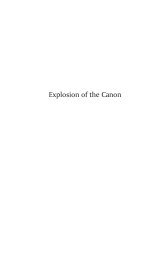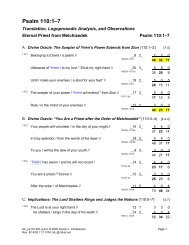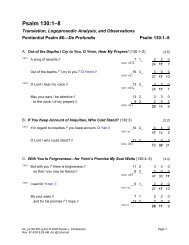Reading Genesis 1-2 in Hebrew - Bibal.Net
Reading Genesis 1-2 in Hebrew - Bibal.Net
Reading Genesis 1-2 in Hebrew - Bibal.Net
Create successful ePaper yourself
Turn your PDF publications into a flip-book with our unique Google optimized e-Paper software.
<strong>Read<strong>in</strong>g</strong> <strong>Genesis</strong> 1–2 <strong>in</strong> <strong>Hebrew</strong><br />
���������‘������û������������„<br />
����‘������—transliteration: ˚-b¸-kol hA-reµ-meW hA-rO-mEµW val-hA-'Aµ-rec, “and<br />
over all crawl<strong>in</strong>g th<strong>in</strong>gs that crawl on the earth.” The verbal form WEmOrAh is Qal active participle<br />
sg. masc. from the root Wmr (“creep, crawl, move about”) with the def<strong>in</strong>ite article. Note the<br />
compensatory lengthen<strong>in</strong>g of the vowel of the def<strong>in</strong>ite article because the follow<strong>in</strong>g r cannot be<br />
doubled and is thus treated as though it were a guttural. The preposition lav (“on”) is attached to<br />
its object erA'µAh (“the earth”) by maqqEp, with compensatory lengthen<strong>in</strong>g of the vowel under the<br />
def<strong>in</strong>ite article and pausal lengthen<strong>in</strong>g of the vowel of the penult.<br />
��������������������‘��������‹ �������������œ•���1:27�<br />
���������û������„<br />
���������û��������������������„<br />
���������û���������<br />
�������������������‘��������‹ �������������œ•��—transliteration:<br />
way-yib-rAµ' 'È-lO-hÓµm 'et-hA-'A-dAµm<br />
B¸-cal-mÙµ, “and Elohim created the human <strong>in</strong> his own image” The verb here is Qal imperfect 3 rd<br />
sg. masc. from the root 'rb (“create”) with Elohim as subject and £AdA'Ah (“the human”) as<br />
def<strong>in</strong>ite direct object. The masc. segholate noun £elec (“image”) has the preposition b (“<strong>in</strong>”) as<br />
prefix and the 3 rd sg. pronom<strong>in</strong>al suffix Ùñ (“his”). Before suffixes, segholates take what is called<br />
their primary form—the orig<strong>in</strong>al form of the noun, which had but one vowel, that vowel stand<strong>in</strong>g<br />
under the first root letter.<br />
���������������„<br />
���������û<br />
����—transliteration: B¸-ceµ-lem 'È-lO-hÓµm BA-rAµ' 'O-tÙµ, “<strong>in</strong> the image of<br />
Elohim he created him.” The verb here is Qal perfect 3 rd sg. masc. from the root 'rb (“create”)<br />
with Elohim as subject. The def<strong>in</strong>ite direct object marker tE' has the 3 rd sg. masc. prom<strong>in</strong>al suffix<br />
Ùñ (“his”). With pronom<strong>in</strong>al suffixes the vowel changes <strong>in</strong> this “mark of the accusative” from Eñ (E)<br />
to Oñ (O). Accord<strong>in</strong>g to BDB (p. 84), “In <strong>Hebrew</strong> the ground-form is tÙ'.”<br />
���������û������„<br />
���������û�������›����—transliteration:<br />
zA-kAµr ˚-n¸-qE-b‰µ BA-rAµ' 'O-tAµm, “male and female<br />
he created them.” The masc. noun rAkƒz (“male”) and the fem. noun hAbEq¯n (“female”) together<br />
constitute the “image” of G-d. The wau-conjunction become ˚ before shewa. The def<strong>in</strong>ite direct<br />
object marker tE' has the 3 rd pl. masc. pronom<strong>in</strong>al suffix £Añ (“them”).<br />
�����������������������œ•��˜�����������������������•���1:28�<br />
���������������„<br />
����‘�����û��������_������û��π�����<br />
�����������������������œ����‹<br />
•�������›���������<br />
���������‘��������û���������„<br />
�œ��‘�����������<br />
�����������������������•��—transliteration:<br />
wa-y¸-bAµ-rek 'O-tAµm 'È-lO-hÓµmü, “and Elohim blessed them”<br />
The verb is Piel imperfect 3 rd sg. masc. with wau-conversive from the root ¢rb (“bless”) with<br />
© 2005 BIBAL Corporation, All Rights Reserved Version 1.0<br />
18





